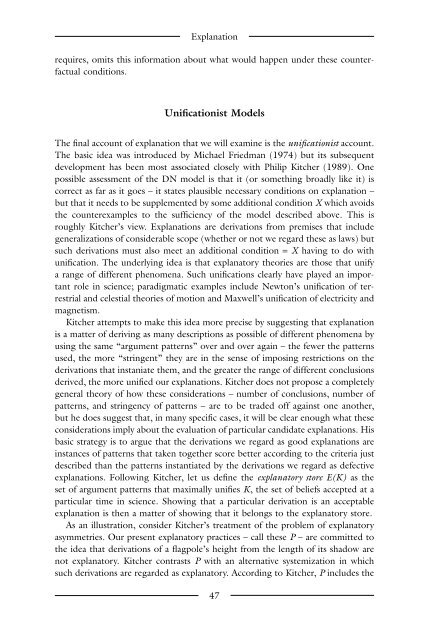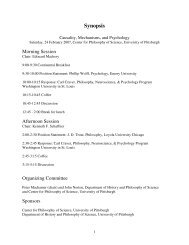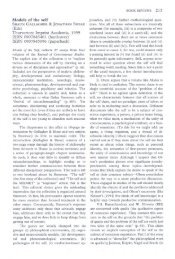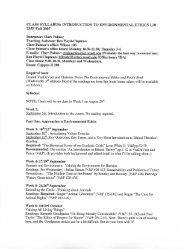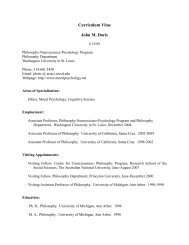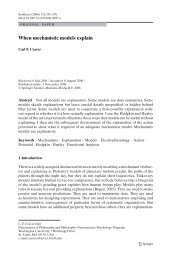The Blackwell Guide to the Philosophy of Science - The Department ...
The Blackwell Guide to the Philosophy of Science - The Department ...
The Blackwell Guide to the Philosophy of Science - The Department ...
Create successful ePaper yourself
Turn your PDF publications into a flip-book with our unique Google optimized e-Paper software.
Explanation<br />
requires, omits this information about what would happen under <strong>the</strong>se counterfactual<br />
conditions.<br />
Unificationist Models<br />
<strong>The</strong> final account <strong>of</strong> explanation that we will examine is <strong>the</strong> unificationist account.<br />
<strong>The</strong> basic idea was introduced by Michael Friedman (1974) but its subsequent<br />
development has been most associated closely with Philip Kitcher (1989). One<br />
possible assessment <strong>of</strong> <strong>the</strong> DN model is that it (or something broadly like it) is<br />
correct as far as it goes – it states plausible necessary conditions on explanation –<br />
but that it needs <strong>to</strong> be supplemented by some additional condition X which avoids<br />
<strong>the</strong> counterexamples <strong>to</strong> <strong>the</strong> sufficiency <strong>of</strong> <strong>the</strong> model described above. This is<br />
roughly Kitcher’s view. Explanations are derivations from premises that include<br />
generalizations <strong>of</strong> considerable scope (whe<strong>the</strong>r or not we regard <strong>the</strong>se as laws) but<br />
such derivations must also meet an additional condition = X having <strong>to</strong> do with<br />
unification. <strong>The</strong> underlying idea is that explana<strong>to</strong>ry <strong>the</strong>ories are those that unify<br />
a range <strong>of</strong> different phenomena. Such unifications clearly have played an important<br />
role in science; paradigmatic examples include New<strong>to</strong>n’s unification <strong>of</strong> terrestrial<br />
and celestial <strong>the</strong>ories <strong>of</strong> motion and Maxwell’s unification <strong>of</strong> electricity and<br />
magnetism.<br />
Kitcher attempts <strong>to</strong> make this idea more precise by suggesting that explanation<br />
is a matter <strong>of</strong> deriving as many descriptions as possible <strong>of</strong> different phenomena by<br />
using <strong>the</strong> same “argument patterns” over and over again – <strong>the</strong> fewer <strong>the</strong> patterns<br />
used, <strong>the</strong> more “stringent” <strong>the</strong>y are in <strong>the</strong> sense <strong>of</strong> imposing restrictions on <strong>the</strong><br />
derivations that instaniate <strong>the</strong>m, and <strong>the</strong> greater <strong>the</strong> range <strong>of</strong> different conclusions<br />
derived, <strong>the</strong> more unified our explanations. Kitcher does not propose a completely<br />
general <strong>the</strong>ory <strong>of</strong> how <strong>the</strong>se considerations – number <strong>of</strong> conclusions, number <strong>of</strong><br />
patterns, and stringency <strong>of</strong> patterns – are <strong>to</strong> be traded <strong>of</strong>f against one ano<strong>the</strong>r,<br />
but he does suggest that, in many specific cases, it will be clear enough what <strong>the</strong>se<br />
considerations imply about <strong>the</strong> evaluation <strong>of</strong> particular candidate explanations. His<br />
basic strategy is <strong>to</strong> argue that <strong>the</strong> derivations we regard as good explanations are<br />
instances <strong>of</strong> patterns that taken <strong>to</strong>ge<strong>the</strong>r score better according <strong>to</strong> <strong>the</strong> criteria just<br />
described than <strong>the</strong> patterns instantiated by <strong>the</strong> derivations we regard as defective<br />
explanations. Following Kitcher, let us define <strong>the</strong> explana<strong>to</strong>ry s<strong>to</strong>re E(K) as <strong>the</strong><br />
set <strong>of</strong> argument patterns that maximally unifies K, <strong>the</strong> set <strong>of</strong> beliefs accepted at a<br />
particular time in science. Showing that a particular derivation is an acceptable<br />
explanation is <strong>the</strong>n a matter <strong>of</strong> showing that it belongs <strong>to</strong> <strong>the</strong> explana<strong>to</strong>ry s<strong>to</strong>re.<br />
As an illustration, consider Kitcher’s treatment <strong>of</strong> <strong>the</strong> problem <strong>of</strong> explana<strong>to</strong>ry<br />
asymmetries. Our present explana<strong>to</strong>ry practices – call <strong>the</strong>se P – are committed <strong>to</strong><br />
<strong>the</strong> idea that derivations <strong>of</strong> a flagpole’s height from <strong>the</strong> length <strong>of</strong> its shadow are<br />
not explana<strong>to</strong>ry. Kitcher contrasts P with an alternative systemization in which<br />
such derivations are regarded as explana<strong>to</strong>ry. According <strong>to</strong> Kitcher, P includes <strong>the</strong><br />
47


